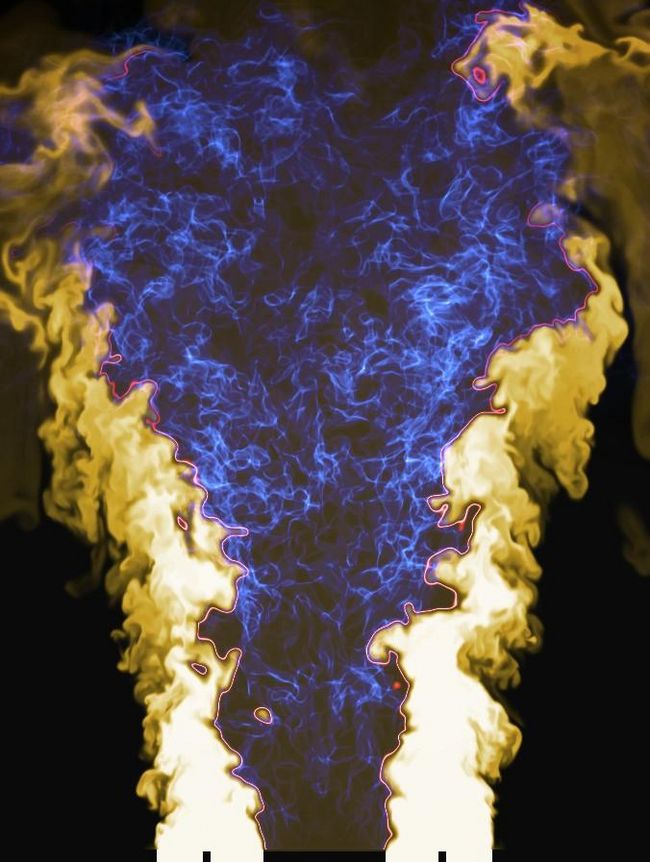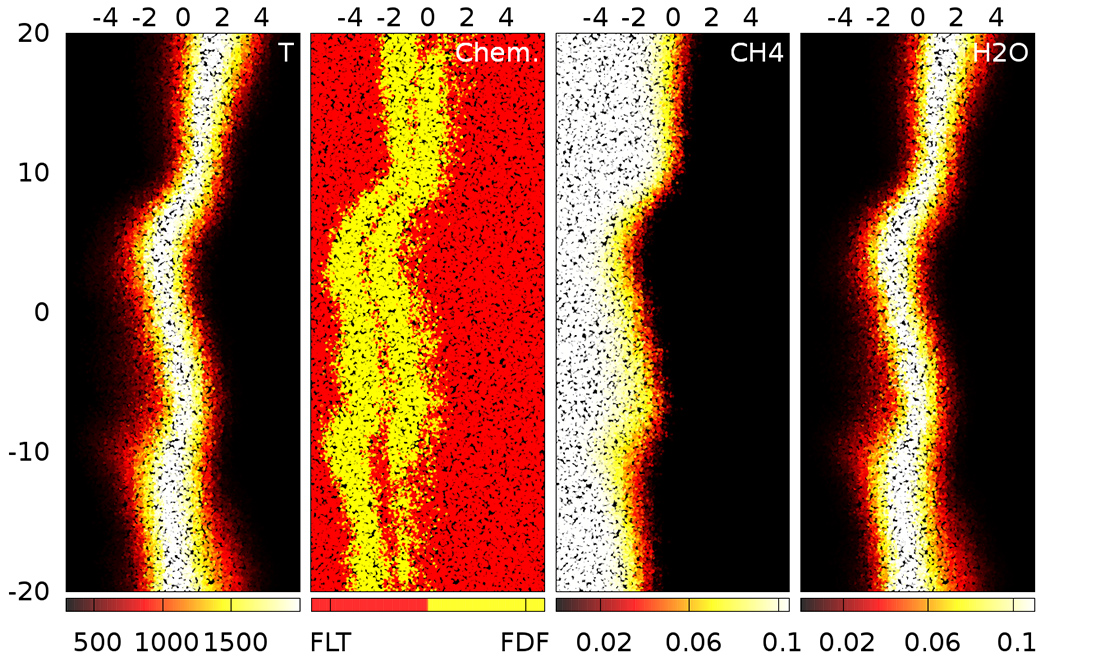ENVIRONMENT AND ENERGY
Investigations into Turbulent Flames with Detailed Chemistry and Detailed Transport
Principal Investigator:
Andreas Kempf
Affiliation:
Institut für Verbrennung und Gasdynamik, Lehrstuhl Fluiddynamik, Universität Duisburg-Essen (Germany)
Local Project ID:
hdu18
HPC Platform used:
JUQUEEN of JSC
Date published:
Turbulence-chemistry interaction in well characterized partially premixed and premixed laboratory-scale experiments has been investigated numerically by two different methods (M1 & M2) based on the large eddy simulation (LES) technique. It could be shown that the developed transported filtered density function method (M1) is capable of reproducing the turbulence chemistry interaction in the investigated opposed jet flame configurations. The flame resolved simulations (M2) revealed the importance of flame wrinkling and scalar geometry for flame propagation and allowed for further development of sub-filter models for future LES.
World energy demand is mainly covered by burning fossil fuels. A detailed understanding of the complex physical and chemical processes involved is required to develop clean and efficient combustion devices. Numerical analysis increasingly helps to understand combustion, exploiting the rapid increase of computational power. As combustion in technical devices occurs under turbulent conditions, the numerical investigation of the interplay between turbulence and chemical reactions is of high interest.
The fundamental problem of numerical turbulent combustion research is that fully resolving all relevant scales of turbulence and chemistry in a technical combustion device requires computational resources unavailable in the foreseeable future. One promising approach is the large eddy simulation (LES), where most of the relevant flow scales are resolved and only the smallest scales are modelled. This is justified by the smallest scales generally showing a universal behaviour. However, combustion mostly occurs on the unresolved scales where the chemistry interacts with the smallest eddies, making modelling a difficult task.

Figure 1: Visualization of the quasi direct numerical simulation (M2) of the Cambridge stratified burner. The simulation has 1.6 billion cells and has been computed on 64,000 cores. Volume rendering of the reaction source term (blue) as well as the reaction source term (purple) and the reactant density (yellow) in the burner mid-section are shown.
Copyright: Universität Duisburg-EssenWithin this project, which has been performed on JUQUEEN, scientists of the Universität Duisburg-Essen investigated the interplay between turbulence and chemistry by two different methods in the context of LES for well measured laboratory experiments. The first method (M1) is based on an approach where the small scale mixing and reaction is described by means of a particle based Monte Carlo method. The second method (M2) relies on a simplified description of the chemistry, which however allows to fully resolve the interaction between simplified chemistry and turbulence.
The simulations of partially premixed and premixed experimental configurations with M1 showed a good agreement with the experiments. A detailed comparison of the turbulence-chemistry interaction between simulation and experiment showed that the interaction is well reproduced by the simulation for both the diffusion and premixed dominated combustion modes.
The second method M2 provided highly resolved velocity and scalar fields, which were used in two ways. First, the full information was used to investigate the interaction of turbulence and combustion chemistry on the smallest scales. The importance of the wrinkling of the flame and the alignment between flame normal direction and velocity gradient for the flame propagation speed was shown for a lab-scale flame. In a second step, the fields were filtered so that detailed statistics of the sub-filter flame wrinkling could be generated. These statistics enabled the validation and further development of sub-filter models, which can be used for precise LES predictions of technical combustors.

Figure 2: Monte Carlo particles representing the scalar fields (M1) in plane cutting though the flame in the Darmstadt turbulent opposed jet burner. From left to right: temperature, type of chemical model, methane mass fraction, water vapor mass fraction. Approximately 32x103particles are shown per sub-plot.
Copyright: Universität Duisburg-EssenScientific Contact:
Prof. Dr.-Ing. Andreas Kempf
Institut für Verbrennung und Gasdynamik, Lehrstuhl Fluiddynamik
Universität Duisburg-Essen
Carl-Benz-Str. 199, D-47057 Duisburg (Germany)
e-mail: andreas.kempf @ uni-due.de